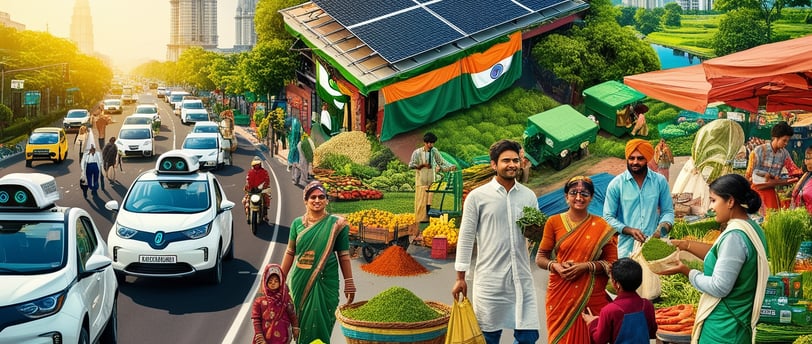The Rise of Green Marketing: How Sustainability is Changing the Business Game
See how Indian businesses are going green with solar panels, electric vehicles, and eco-friendly products. Learn how this shift impacts customers and inspires new ideas for a better future.
Astitva Dubey
11/30/20243 min read


The Rise of Green Marketing: How Sustainability is Changing the Business Game
A Sustainable Awakening
A few months ago, while scrolling through Instagram, I stumbled upon a post by an Indian fashion brand claiming their t-shirts were "made from 100% recycled plastic bottles." I was intrigued and skeptical. Could my fashion choices really contribute to reducing plastic waste? It was the first time I paused to consider how the products I buy might impact the planet.
That moment sparked a journey of discovery, one that made me notice a shift happening all around. From organic snacks at my local grocery store to electric vehicles zipping past on Indian roads, businesses seemed to be wearing their sustainability badges with pride. But was this just a trend or a revolution in the making? In my opinion, it’s a mix of both—a rising movement that’s reshaping the business landscape in India.
The Green Consumer in India
What I’ve learned is that Indian consumers, especially young people like us, are becoming more environmentally conscious. There’s this shared realization that our choices matter—not just for us, but for the future. According to a 2022 survey by Statista, over 60% of urban Indian consumers prefer eco-friendly products, even if they cost more.
But why this sudden shift? In my view, it’s a mix of awareness campaigns, social media influence, and plain old practicality. For example, when Delhi’s air pollution peaks every winter, the harsh reality of environmental neglect hits home. It’s not just about being trendy; it’s about survival.
Personal Reflection:
I remember a conversation with my grandmother about how markets used to operate before plastic bags took over. She recalled a time when cloth bags and glass bottles were the norm. It made me wonder—have we just forgotten sustainable practices in the race for convenience? Green marketing, in many ways, feels like a return to those roots, albeit with a modern twist.
Green Marketing in Action: Indian Examples
One thing that stands out is how Indian businesses are embracing green marketing. Here are some examples that inspired me:
Tata Power and Renewable Energy:
Tata Power, one of India’s largest electricity providers, has launched initiatives to promote solar energy adoption among households. Through campaigns like Switch to Green, they’ve educated thousands on how switching to renewable energy can reduce carbon footprints.Why It Works:
The messaging is simple yet impactful. It appeals to the middle-class Indian’s desire to save on electricity bills while contributing to a greener planet.Patanjali’s Natural Products:
In my experience, you can’t visit a pharmacy or grocery store in India without seeing Patanjali’s products. Their marketing heavily emphasizes “natural,” “herbal,” and “environmentally friendly.” While some claims are debatable, their strategy resonates with Indian consumers who trust Ayurvedic and traditional solutions.Ola Electric’s EV Push:
Ola Electric has cleverly positioned itself as more than just a vehicle manufacturer. Their campaigns highlight how switching to electric vehicles (EVs) can reduce dependence on fossil fuels and curb pollution.Fun Fact:
Did you know that India’s EV market is projected to grow at a staggering 94% annually by 2030 (IEA Report, 2023)? Brands like Ola are leading this charge, literally and figuratively.
Challenges in Green Marketing
Of course, not everything is sunshine and solar panels. What I’ve noticed is that many brands struggle with “greenwashing”—a practice where they exaggerate their eco-friendly claims.
Anecdote:
A few months ago, I bought a “biodegradable” water bottle from a popular brand. Only later did I discover it wasn’t as biodegradable as advertised. It felt like I’d been duped, and I’m sure many of you can relate to this frustration.
This kind of marketing can backfire, eroding consumer trust. It’s essential for brands to be transparent about their practices. After all, today’s consumers (especially Gen Z) are quick to call out dishonesty on social media.
Why Green Marketing Matters in India
India is uniquely positioned to benefit from green marketing. Here’s why:
Environmental Urgency:
India is among the most vulnerable countries to climate change, facing challenges like rising temperatures, water scarcity, and pollution. Businesses adopting sustainable practices contribute to solutions for these pressing issues.Cultural Alignment:
Indian culture has always emphasized harmony with nature. Concepts like Ahimsa (non-violence) and Jal, Jungle, Zameen (water, forest, land) align beautifully with modern sustainability principles.Economic Opportunity:
Green marketing isn’t just good for the planet—it’s good for business. The global market for eco-friendly products is expected to reach $150 billion by 2030, and Indian companies are tapping into this lucrative space.
Lessons for Aspiring Entrepreneurs
As a business student, I often think about how I’d implement green marketing strategies if I ever start my own venture. Here are a few takeaways:
Start Small but Stay Genuine:
Whether it’s using biodegradable packaging or sourcing raw materials ethically, even small steps can make a big impact. But honesty is key—don’t overpromise.Educate Your Audience:
Not everyone understands what “sustainable” means. Use simple language and relatable examples to explain your efforts.Leverage Technology:
Apps like ecoVadis allow businesses to measure and improve their sustainability practices. Tools like these make it easier to integrate green strategies.
